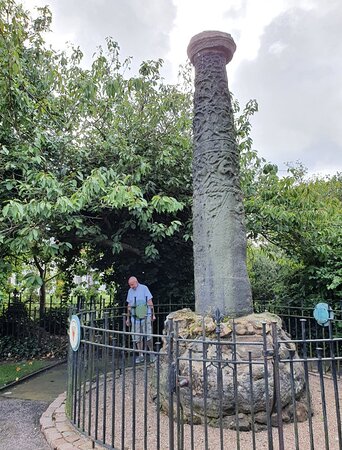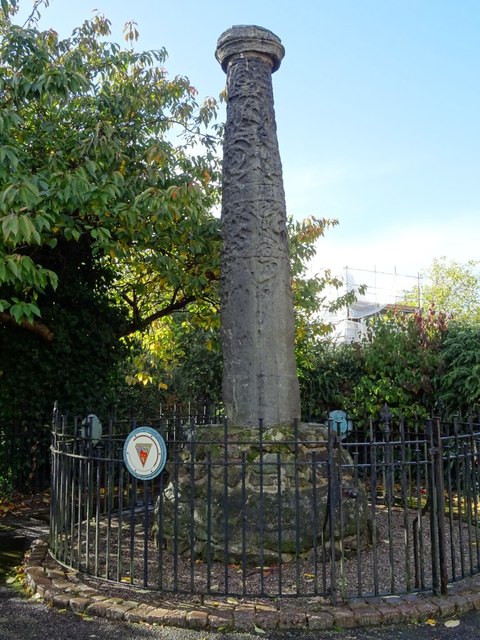Wulfruna’s Column, an enduring relic of England’s medieval history, stands on what was once the highest point in Wolverhampton. This weathered stone structure, darkened by centuries of exposure to the elements and industrial pollution, has witnessed the transformation of the region through multiple cultural and political upheavals. Despite its weathered appearance, the column’s historical significance is undeniable. It not only serves as a testament to the life of Wulfrun, an influential Anglo-Saxon noblewoman, but also reflects the complex and dynamic past of the Kingdom of Mercia and the broader British landscape.
Origins: Wulfrun and the Foundation of Wolverhampton
The column is named after Wulfrun, a notable Anglo-Saxon noblewoman who played a crucial role in the establishment of Wolverhampton. In the early 900s, following the Viking defeat at nearby Tettenhall in 910, Wulfrun founded an abbey on this site and lent her name to the town. Her legacy is intertwined with the turbulent history of the time, marked by Viking invasions and shifting allegiances. Wulfrun’s personal story is equally dramatic—captured as a child from Tamworth Castle by Olaf Sihtricsson, a Danish leader, in 943. Her captivity under the Danes symbolizes the broader Viking presence in England and the challenges faced by Anglo-Saxon families during this period.

The Column’s Mysterious Origins
Though the column bears Wulfrun’s name, there is no definitive evidence that she was directly responsible for its installation. Historians and archaeologists have speculated that the column may have originally come from the Roman bathhouses of Wroxeter in Shropshire, once the fourth-largest Roman town in Britain. As Roman authority receded, Wroxeter faced decline, and in the 500s, local Romano-Britons attempted to revive the town by repurposing Roman structures. However, these attempts were abandoned after the population moved to Shrewsbury to escape a devastating plague, leaving behind remnants of their efforts, including the stone column that would eventually find its way to Wolverhampton.

A Symbol of Cultural Synthesis
By the time the column arrived in Wolverhampton, it had undergone significant transformations. Repurposed and placed on the town’s highest hill, it was adorned with intricate carvings of birds, animals, and plants. These carvings reflect a unique “Saxon Byzantine” style, representing the blending of Anglo-Saxon, Roman, and Christian influences that characterized the medieval period. The column also featured a cross at its summit, symbolizing the spread of Christianity across Britain during this time.

This fusion of cultural elements—pagan and Christian, Roman and Saxon—serves as a visual representation of the broader shifts happening in England during the medieval period. Christianity was gaining ground, and with it came the repurposing of earlier structures for religious and symbolic purposes, such as this column.
Puritan Iconoclasm and the Column’s Downfall
Despite its prominence, Wulfruna’s Column eventually fell victim to the iconoclastic movements of the 1600s. During this time, Puritan reformers sought to remove or destroy religious symbols associated with Catholicism and the Church of England. It is widely believed that Richard Baxter, a leading Puritan minister who was known for his efforts to remove religious symbols in places like Kidderminster, may have been involved in the destruction of the cross atop the column.

Iconoclasm during the Puritan era was a reaction against the perceived idolatry of religious symbols, and it led to the defacement or removal of many structures throughout England. The column in Wolverhampton, once a symbol of Christian faith and Anglo-Saxon heritage, became yet another casualty of this movement.
A Legacy of England’s Changing Religious and Political Landscape
Though disfigured, Wulfruna’s Column endures as a relic of the changing tides of England’s religious, political, and cultural landscapes. From its origins as a Roman column to its repurposing in medieval times, the column reflects the ongoing adaptation of cultural symbols. Its survival, despite the Puritan attempts to erase its Christian iconography, also speaks to the resilience of historical monuments and the complex legacy of England’s medieval past.
Wulfruna’s Column serves as a reminder of the multifaceted history of England during the Anglo-Saxon period, the Roman occupation, and the transition to Christianity. It embodies the life of Wulfrun, whose contributions to the founding of Wolverhampton and the Kingdom of Mercia have left a lasting imprint on the region. The column’s enduring presence, albeit in a somewhat altered form, reflects the deep-rooted history of the area, offering valuable insights into the development of early medieval England.
Conclusion: Wulfruna’s Column as a Historical Marker
Wulfruna’s Column, despite its erosion and damage, remains an important marker of England’s history, rich in both cultural and religious significance. It highlights the intersection of Anglo-Saxon and Roman heritage, the spread of Christianity, and the rise of Puritan reforms in the 17th century. Standing as a symbol of endurance, this monument continues to captivate historians and visitors alike, offering a tangible connection to the complex history of Wolverhampton and the broader Kingdom of Mercia.
